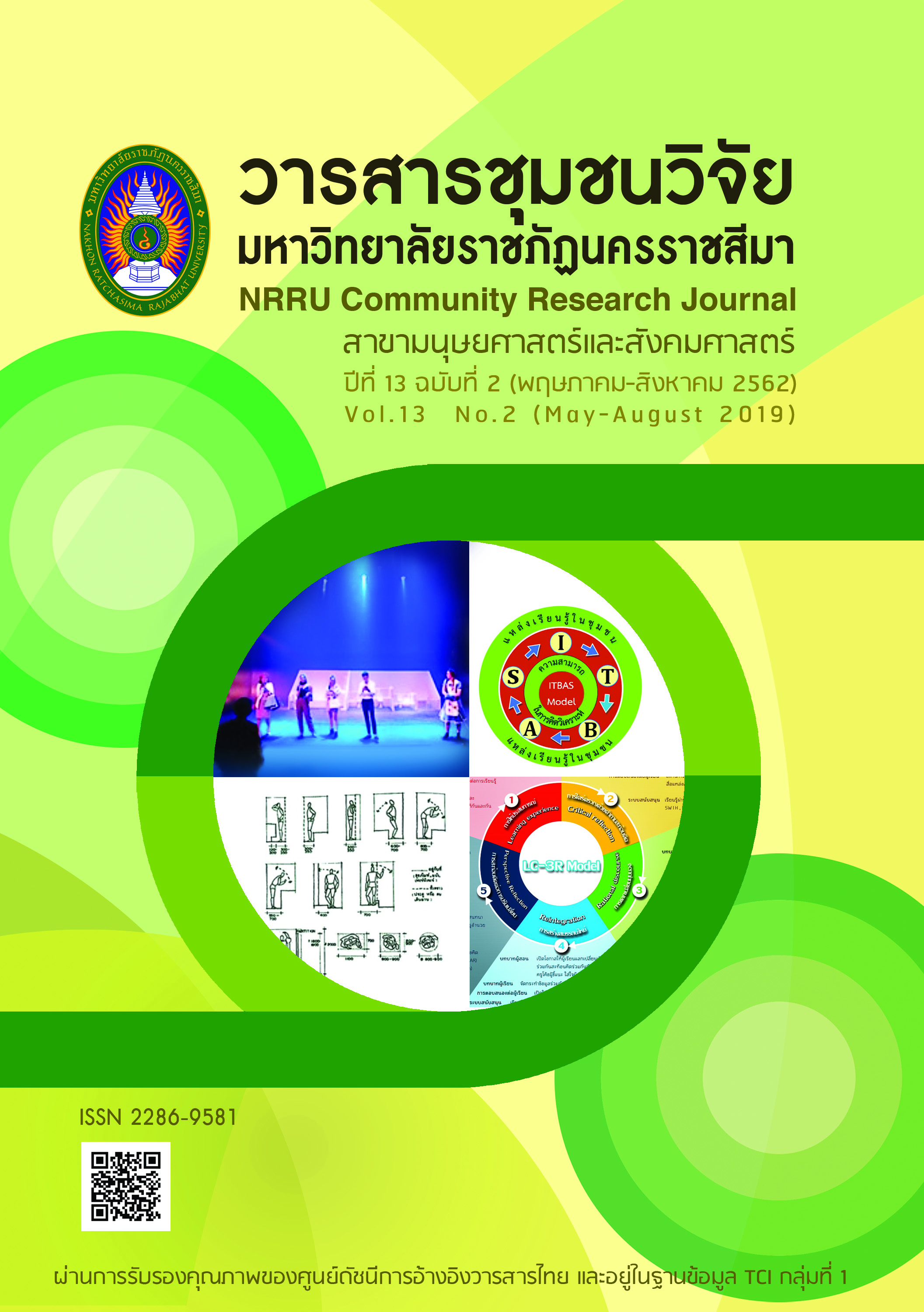THE DEVELOPMENT OF TEACHING MODEL USING COMMUNITY LEARNING RESOURCES TO ENHANCE ANALYTICAL THINKING ABILITY OF MATTHAYOM 3 (GRADE 9) STUDENTS
DOI:
https://doi.org/10.14456/10.14456/nrru-rdi.2019.26Keywords:
The development of teaching model, Community learning resources, Analytical thinking abilityAbstract
The research objectives were to 1) develop a teaching model; 2) study the results of using the teaching model by comparing students’ ability; and 3) study the students’ learning satisfaction toward the use of teaching model via community learning resources to enhance the analytical thinking ability of Matthayom 3 students at Thetsaban 1 School (Burapha Witthayakon), under the authority of Educational Division of Nakhon Ratchasima Municipality, on 2nd semester of the academic year 2017. The research participants consisted of 148 students selected from 3 classrooms. The collected data were used to design and develop a teaching model. The research instruments consisted of 1) a plan of learning management carried the highest level of general quality ( =4.93); and 2) the reliability of the whole test at 0.92, and a questionnaire of satisfaction with IOC at 1.00 on every item and the reliability of the whole questionnaire at 0.96 both test and questionnaire were from the 48 participants selected by using cluster random sampling method. Finally, the satisfaction results were studied by assessing for mean and standard deviation. The research findings revealed that the developed teaching model called ITBAS Model carried the efficiency level at 81.54/81.18 which illustrated that it met the defined criteria. After teaching, it showed that the students had analytical thinking ability higher than they did before teaching with significance in statistic at 0.05. Moreover, the students’ satisfaction toward the teaching model was in the highest level in general (
=4.72).
References
Bruner, J. (1963). The Process of education. New York : Alfred A. Knoopf, Inc. and Random House.
Buri-Suwan, C., & Uamchareon, S. (2017). Teaching and learning styles Development, watching, listening and reading to enhance the analytical thinking and rational thinking for early secondary school students. Veridian E-Journal, Silpakorn University, Thai version, Humanities, Social Sciences and Arts, 10(2), 318-335. (In Thai)
Changjongpradit, S., Saengthong, S., & Sarawan, P. (2017). Teaching development to improve the analytical thinking skills for elementary school students: a case study of Khao Thong School Phayuha Khiri District, Nakhon Sawan Province. Journal of Social Sciences Academic, 10(Special Edition), 23-39. (In Thai)
Hemmant, L. (2010). Development of analytical thinking ability by using learning cycle management model for Science group of students in grade 4. A thesis for Master of Research and Evaluation Degree, Thaksin University, Songkhla. (In Thai)
Joyce, B., Weil, M., & Calhoun, E. (2004). Models of teaching (7th ed.). Boston : Pearson Education.
Kijmanuwat, N. (2016). Development of teaching styles for developing systematic thinking processes for secondary school students. A Dissertation for Doctor of Philosophy Degree in Curriculum and Instruction, Faculty of Education, Burapha University, Chonburi. (In Thai)
Laoreandee, W. (2010). Learning management strategies and styles to develop thinking skills (5th ed.). Nakhon Pathom : Silpakorn University Printing Factory. (In Thai)
Lumpkin, C. R. (1991). Effects of Teaching Critical Thinking Skills on The Critical Thinking Ability, Achievement, and Retention of Social Studies Content by Fifth and Sixth-Graders. Ph. D. Dissertation Aubrun University. Retrieved May, 1991, from https://proquest.umi.com /pqdweb/?did=745150621&sid=3&Fmt=2&clientId=71090&R QT=309&VName=PQD
Mazano, R. J. (2001). Designing a New Taxonomy of Educational Objective. Thousand Oaks, California : Corwin Press.
Ministry of Education. (2008). Core Education Curriculum for Primary Education, 2551 B.E. Bangkok : Agriculture Cooperatives of Thailand Printing. (In Thai)
Office of the National Economic and Social Development Board. (2011). National Economic and Social Development Plan 11th issued (2012-2016). Bangkok : Office of the Prime Minister. (In Thai)
Phattiyathani, S. (2008). Statistical methods for research (4th ed.). Kalasin : Prasankarnpim printing. (In Thai)
Promwong, C. (1989). Teaching materials, Technology and Communication Studies Module, Unit 1-5. Nonthaburi: Office of Educational Technology, Sukhothai Thammathirat Open University. (In Thai)
Saiyot, L., & Saiyot, A. (1995). Educational research techniques (4th ed.). Bangkok : Suviriyasan. (In Thai)
Sri Sa-ard, O. (2008). Fundamental of Educational Research (4th ed.). Kalasin : Prasankarnpim printing. (In Thai)
Sri Sa-at, B. (2010). Preliminary research (8th ed.). Bangkok : Suviriyasan printing. (In Thai)
Sungraksa, N. (2016). Quality of research strategies: weaknesses and defects from research findings (5th ed.). Nakhon Pathom : Silpakorn University Printing. (In Thai)
Susaoraj, P. (2008). Thinking development. Bangkok : 9119 Technical printing. (In Thai)
Sutthirat, C. (2009). 80 Innovation in learning management that focuses on learners centered. Bangkok : Danex Inter Corporation. (In Thai)
Tesaban 1 School (Burapha Wittayakorn). (2017). National Basic Education Test Result (O-NET) Thai language subjects, Standard 1.1 Mathayomsuksa 3 Tesaban 1 School (Burapha Wittayakorn). Copied documents. (In Thai)
Tesaban 1 School (Burapha Wittayakorn). (2017). Number of students report in Mathayomsuksa 3 Tesaban 1 School (Burapha Wittayakorn). Copied documents. (In Thai)
The Ministry of Education Thailand. (2008). The Basic Education Core Curriculum B.E. 2551 (A.D. 2008). Bangkok : n.p. (In Thai)
Torrance, E. P. (1962). Guiding creative talent. NJ : Prentice-Hall.
Yang Lizhou. (2555). Model of teaching/thai language reading comprehension/students of Yunnan university of nationalities/ active reading theory/cooperative learning principles. A Dissertation for doctor of Philosophy Program in Curriculum and instruction, Burapha University, Chonburi. (In Thai)




